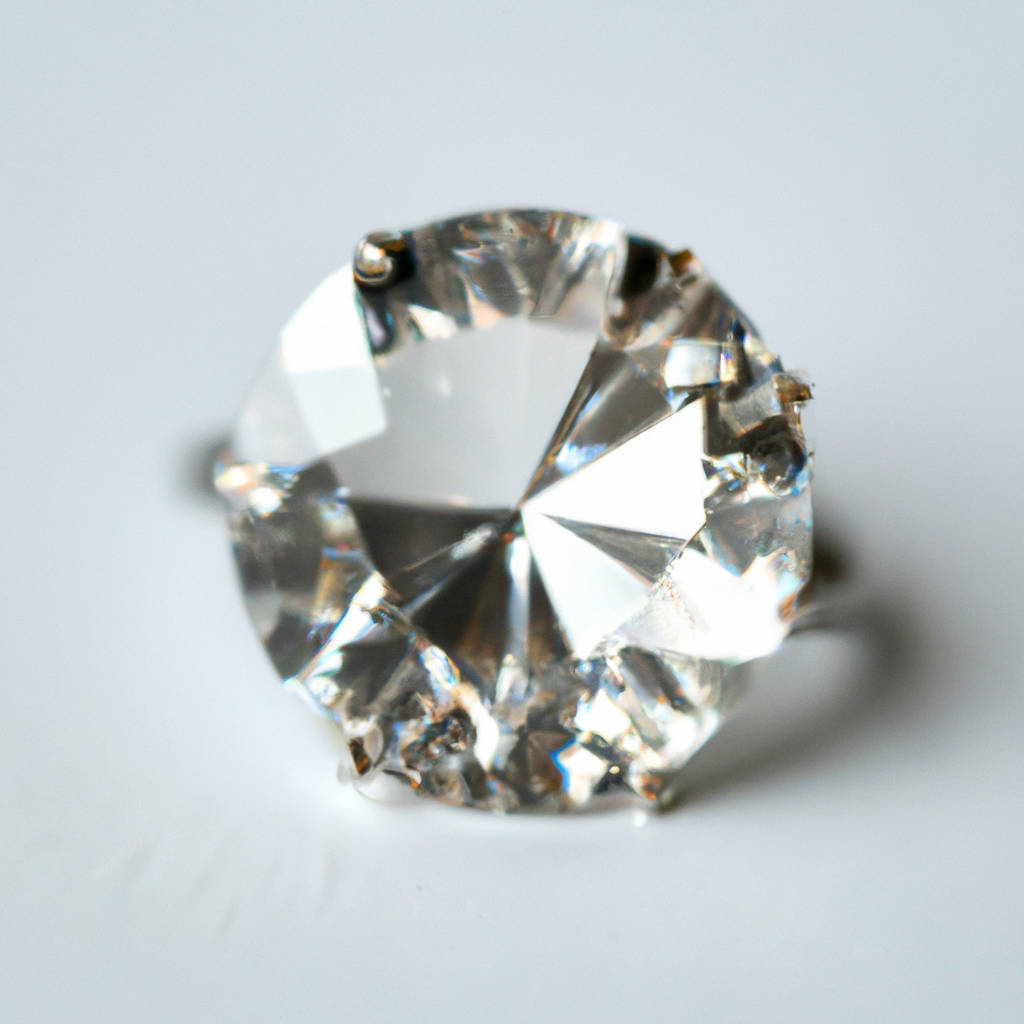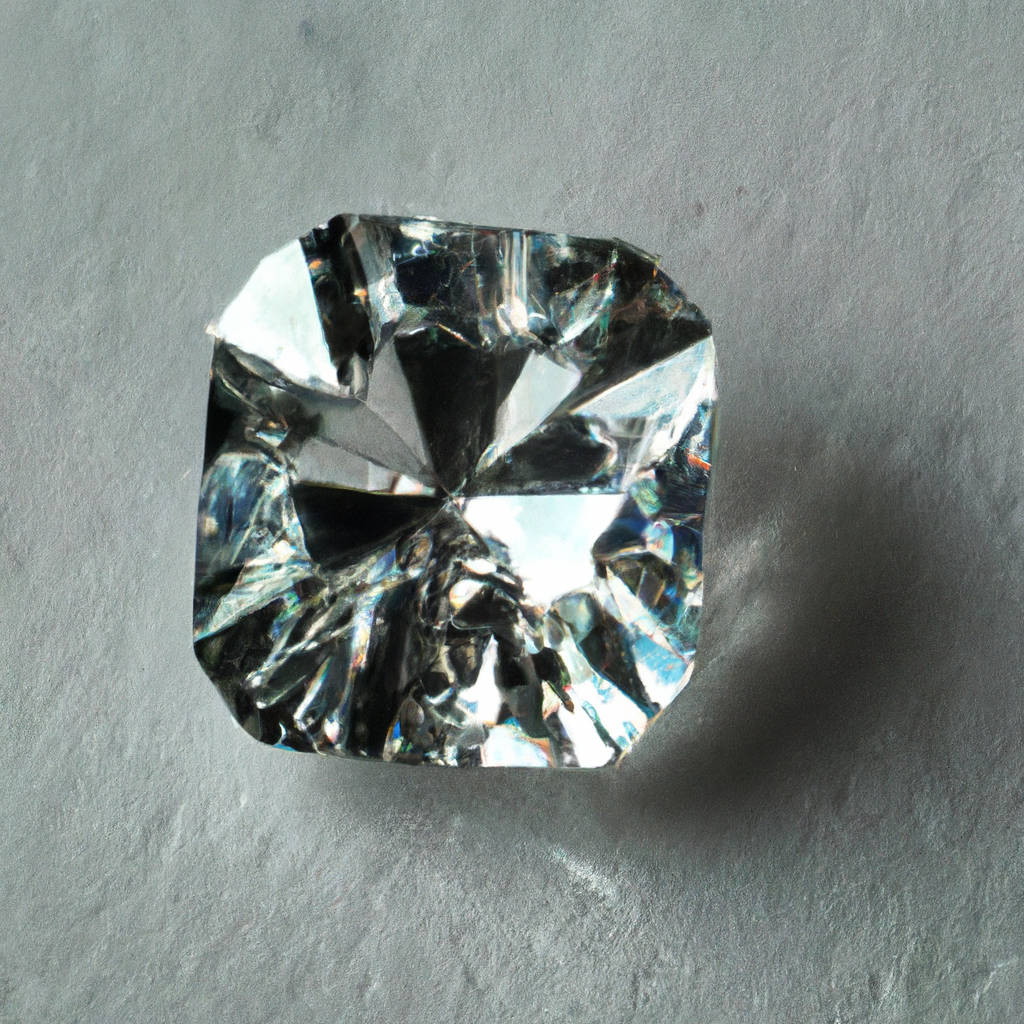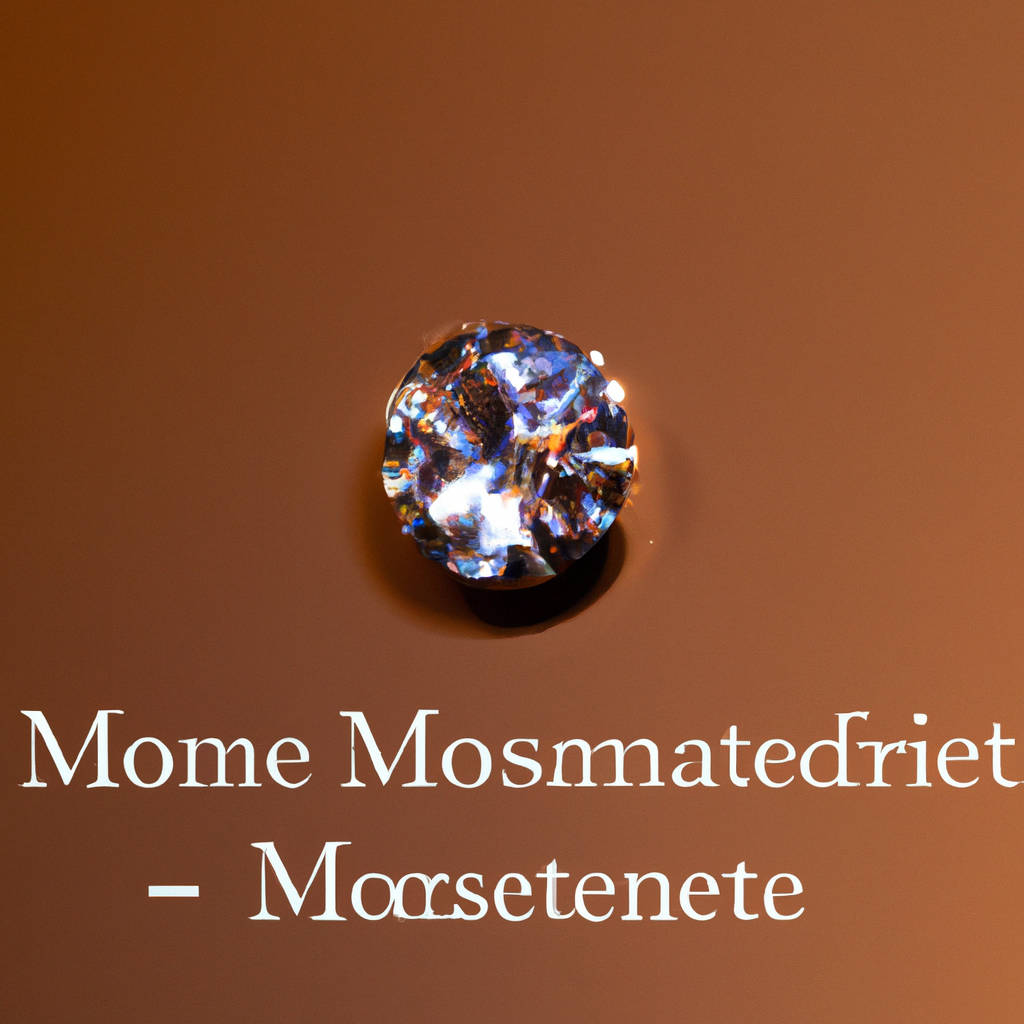Moissanite is a remarkable gemstone that has gained popularity in recent years as an alternative to traditional diamonds. It is a lab-created gemstone that possesses similar optical and physical properties to diamond, making it an attractive choice for those seeking a brilliant and durable stone for jewelry.
Originally discovered by French chemist Henri Moissan in a meteor crater in Arizona, moissanite is composed of silicon carbide. Its crystal structure makes it one of the hardest substances on Earth, second only to diamond. This hardness ensures that moissanite is resistant to scratching, making it suitable for everyday wear without worrying about damage.
One of the most appealing aspects of moissanite is its exceptional brilliance and fire. Due to its high refractive index, moissanite reflects light brilliantly, creating a stunning play of colors. When exposed to light, it sparkles and scintillates, captivating the eye with its radiant beauty. This unique optical property sets moissanite apart from other gemstones, giving it a distinctive and captivating appeal.
Another advantage of moissanite is its affordability compared to diamonds. While diamonds are valued for their rarity, moissanite can be produced in a laboratory, making it more accessible and budget-friendly. This affordability allows individuals to acquire larger, more impressive gemstones without breaking the bank.
Furthermore, moissanite is an ethical choice for those concerned about the environmental and social impact of diamond mining. As a lab-created gemstone, it does not require mining, eliminating the potential for environmental degradation and exploitation of workers. This aspect appeals to many individuals who wish to make a conscious and responsible choice when purchasing jewelry.
In conclusion, moissanite is a stunning and durable gemstone that offers an affordable and ethical alternative to traditional diamonds. Its brilliance, fire, and exceptional durability make it an attractive choice for jewelry enthusiasts. Whether one is seeking an engagement ring, earrings, or a pendant, moissanite provides a captivating and ethical option that can effortlessly complement any style.

How is Moissanite Graded for Color
Moissanite is a stunning gemstone that has gained popularity as a diamond alternative due to its brilliance, fire, and affordability. When it comes to grading moissanite for color, several factors are taken into consideration to determine its quality and value.
Color grading in moissanite is a vital aspect as it plays a significant role in determining the gemstone’s overall appearance. Unlike diamonds, moissanite is not graded on the traditional diamond color scale, which ranges from D (colorless) to Z (light yellow or brown). Instead, moissanite is graded using a different color scale specifically developed for this gemstone.
The Gemological Institute of America (GIA) has developed a color grading system for moissanite, known as the GIA Moissanite Color Grading Scale. This scale evaluates moissanite’s color based on three essential components: hue, tone, and saturation.
Hue refers to the primary color visible in the moissanite gemstone. The scale includes various hues such as colorless, near-colorless, faint yellow, and faint green. Colorless moissanite is highly sought after because it closely resembles a diamond and is considered the most valuable. Near-colorless moissanite is also highly desirable and appears nearly colorless to the naked eye.
Tone is the term used to describe how light or dark the moissanite appears. The GIA grading scale ranges from light to dark, with the ideal tone being neither too light nor too dark. The tone is determined by the amount of color present in the gemstone, with lighter tones being more desirable.
Saturation refers to the intensity of color in the moissanite gemstone. This component is evaluated on a scale ranging from low to high saturation. Gems with low saturation will appear more muted, while those with high saturation will exhibit a more vibrant and intense color. Moissanite with higher saturation levels is generally considered more valuable.
To accurately grade moissanite for color, gemologists use specialized tools and lighting conditions. A standardized light source, known as a daylight-equivalent lamp, is employed to ensure consistent and reliable grading. The gemstone is placed under this light source, and its color is assessed with the help of color grading charts and comparison stones.
Gemologists also take into account the size and shape of the moissanite during the grading process. Different cuts and sizes can affect how color is perceived in the gemstone. For instance, larger moissanites may appear to have more color due to their increased surface area, whereas smaller stones may appear whiter or colorless.
It is essential to note that moissanite’s color grading is subjective and can vary between different gemological laboratories or individual gemologists. Therefore, it is advisable to consult a reputable and qualified gemologist or jeweler when purchasing moissanite to ensure accurate color grading and quality assessment.
In conclusion, moissanite is graded for color using the GIA Moissanite Color Grading Scale, which considers the gemstone’s hue, tone, and saturation. This grading system enables gemologists to evaluate the color quality of moissanite accurately. By understanding moissanite’s color grading, consumers can make informed decisions when purchasing this beautiful gemstone.
Is Moissanite Naturally Colorless
Moissanite, a gemstone that has gained significant popularity in recent years, is often touted as an affordable alternative to diamonds. One of the factors that contribute to its appeal is its perceived colorlessness, which leads many to wonder if moissanite is naturally colorless.
To answer this question, we must first understand what moissanite is and how it is formed. Moissanite is a mineral that is composed of silicon carbide, a compound of silicon and carbon. It was first discovered in 1893 by French chemist Henri Moissan, hence its name. However, natural moissanite is extremely rare, and most of the moissanite available today is created in a laboratory.
When moissanite is produced in a lab, it is carefully grown under controlled conditions to mimic the natural process that occurs in the Earth’s crust. This lab-created moissanite is chemically and physically identical to its natural counterpart, except for its origin. In terms of color, moissanite can exhibit a range of hues, including colorless, near-colorless, and yellowish tints.
While it is true that some moissanite gemstones can appear colorless, it is important to note that not all moissanite is naturally colorless. The color of moissanite is influenced by various factors, such as impurities and the growth process used in the lab. Some moissanite stones may exhibit a slight yellow or greenish tint, especially when compared to the exceptional colorlessness of a high-quality diamond.
However, it is worth mentioning that the color of moissanite is generally considered desirable, as it can enhance the stone’s brilliance and fire. In fact, many people prefer the slight warmth that moissanite offers over the icy coolness of a colorless diamond. This preference is subjective and varies from person to person.
To further enhance the colorlessness of moissanite, gem cutters often employ specific cutting techniques. The angles and facets of the stone are carefully calculated to maximize its brilliance and minimize any visible color. This attention to detail ensures that the moissanite appears as colorless as possible to the naked eye.
It is important to distinguish between naturally occurring moissanite and lab-created moissanite when discussing colorlessness. As mentioned earlier, natural moissanite is incredibly rare, and the vast majority of moissanite on the market is created in a lab. Therefore, the colorlessness of moissanite is primarily a result of the growth process and the skill of gem cutters, rather than its natural occurrence.
In conclusion, moissanite can exhibit a range of hues, including colorless, near-colorless, and slight tints of yellow or green. While some moissanite stones may appear colorless, it is important to acknowledge that not all moissanite is naturally colorless. The color of moissanite is influenced by various factors, such as impurities and the growth process used in the lab. However, the skillful cutting techniques employed by gem cutters can enhance the colorlessness of moissanite, making it an appealing option for those seeking an affordable and brilliant gemstone.

Fancy Colored Moissanite
Fancy Colored Moissanite: A Captivating Gemstone Alternative
In the world of gemstones, there is a dazzling array of options available, each with its own unique beauty. Among these gemstones, Fancy Colored Moissanite has emerged as a captivating alternative that is gaining popularity among jewelry enthusiasts. With its vibrant hues and remarkable brilliance, this gemstone offers a mesmerizing allure that is hard to resist.
Moissanite, originally discovered in a meteor crater by French chemist Henri Moissan in 1893, is a rare and naturally occurring mineral. However, the moissanite used in jewelry today is created in laboratories through a process called synthesis, which replicates the conditions found in nature. This process allows scientists to create moissanite gemstones with exceptional clarity, color, and brilliance.
What sets Fancy Colored Moissanite apart is its stunning array of vibrant hues. From deep blues and vivid greens to fiery oranges and striking purples, these gemstones offer a kaleidoscope of colors that can rival even the rarest of natural gemstones. The color of a moissanite gemstone is determined by the presence of trace elements during its creation process, resulting in a wide range of captivating shades.
The allure of Fancy Colored Moissanite lies in its remarkable brilliance. With a refractive index higher than that of most gemstones, moissanite exhibits an extraordinary sparkle that can easily rival that of a diamond. Its ability to reflect light back to the viewer’s eye creates a stunning visual impact, making it a highly sought-after gemstone for jewelry designs.
One of the most appealing aspects of Fancy Colored Moissanite is its affordability. Compared to natural gemstones, moissanite offers a more budget-friendly option without compromising on beauty or quality. This accessibility has made it a popular choice for those seeking to add a touch of extravagance to their jewelry collection without breaking the bank.
Beyond its affordability, Fancy Colored Moissanite also offers ethical benefits. Unlike some natural gemstones that may be associated with unethical mining practices, moissanite is a conflict-free alternative. Its laboratory-grown origins ensure that it is an environmentally conscious choice, making it an appealing option for those who wish to make a socially responsible purchase.
The durability of moissanite is another noteworthy feature. With a hardness rating of 9.25 on the Mohs scale, moissanite is highly resistant to scratches and abrasions, making it suitable for everyday wear. Its robust nature ensures that it can withstand the test of time, making it an excellent investment for those seeking to pass down their jewelry as heirlooms.
In conclusion, Fancy Colored Moissanite is a captivating gemstone alternative that offers a myriad of benefits. Its vibrant hues, remarkable brilliance, affordability, ethical origins, and durability make it an attractive choice for jewelry enthusiasts. Whether used as the centerpiece of an engagement ring or a dazzling pendant, moissanite is sure to captivate hearts and turn heads. Embrace the allure of Fancy Colored Moissanite and indulge in the beauty of this remarkable gemstone.
What does “Treated Moissanite” Mean
Moissanite, a brilliant and ethereal gemstone, has been captivating the hearts of jewelry enthusiasts for years. Its dazzling sparkle and exceptional durability make it a popular choice for those seeking an alternative to traditional diamonds. However, within the world of moissanite, there exists a term that often sparks curiosity and intrigue: “treated moissanite.” But what exactly does this term mean?
To understand the concept of treated moissanite, it is crucial to delve into the natural properties of this remarkable gemstone. Moissanite, originally discovered in a meteorite crater, is composed of silicon carbide. It possesses a unique crystal structure that allows it to refract light in a spectacular way, resulting in a dazzling display of fire and brilliance. However, in its natural state, moissanite can sometimes exhibit slight imperfections or coloring, which some individuals may find less desirable.
This is where the process of treating moissanite comes into play. Treated moissanite refers to the techniques employed to alter or enhance the gemstone’s appearance. These treatments are carried out to address specific concerns or preferences of consumers, ultimately resulting in a more visually appealing gemstone.
One of the most common treatments applied to moissanite is known as color enhancement. This process involves heating the gemstone to high temperatures, which can eliminate or reduce any unwanted coloration. By subjecting moissanite to controlled heat, the gemstone’s hue can be altered, creating a more desirable and colorless appearance. This treatment is particularly sought after by those who prefer a pure and immaculate aesthetic in their jewelry.
Another treatment technique applied to moissanite is called clarity enhancement. Moissanite, like many gemstones, can sometimes contain tiny inclusions or imperfections. These imperfections, though often invisible to the naked eye, may affect the gemstone’s overall clarity. To address this, moissanite can undergo a process known as clarity enhancement. By applying specific substances or techniques, the visibility of these imperfections can be minimized or eliminated, resulting in a gemstone with improved clarity and a flawless appearance.
It is important to note that treated moissanite undergoes these processes to enhance its visual appeal, but it still retains its inherent durability and brilliance. The treatments do not compromise the gemstone’s hardness or resistance to scratches, making it a reliable and long-lasting choice for jewelry.
Treated moissanite offers consumers a wider range of options when it comes to selecting their desired gemstone. From colorless and flawless to vibrant and eye-catching, treated moissanite provides an array of choices to suit individual preferences. However, it is essential to remember that the term “treated” simply refers to the enhancement techniques applied to improve the gemstone’s appearance, rather than suggesting any form of illegality or deception.
In conclusion, treated moissanite refers to the various techniques used to alter and enhance the visual qualities of this captivating gemstone. From color enhancement to clarity enhancement, these treatments aim to provide consumers with a broader range of options when it comes to selecting their desired moissanite. By undergoing these processes, moissanite can offer a flawless and dazzling alternative to traditional diamonds, captivating the hearts of jewelry enthusiasts around the world.

